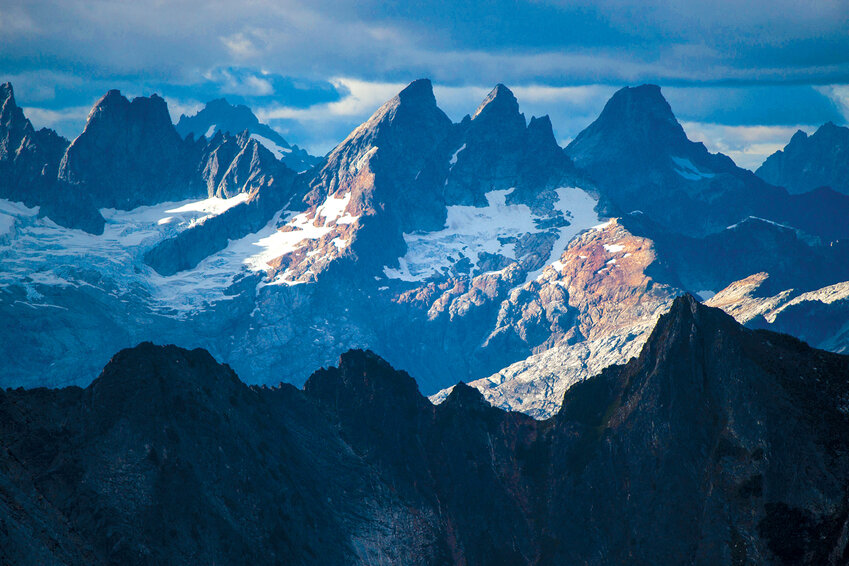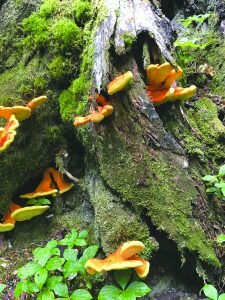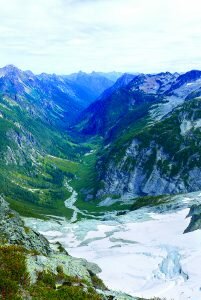 Photo by Jason Griffith.
Photo by Jason Griffith.“What wilderness we decide to save within the next critical decade or two of decision-making will be all we will ever have. Probably it will not be enough…The wilderness of the North Cascades is a national resource of the future, not merely a local commodity, and we need it all, as a nation.” - William O. Douglas, 1965.
The ranger paused when I told her where I wanted to camp that night. “Do you know how far that is?” It was already 10 a.m. and I had just walked into the Glacier Public Service Center. I wanted to hike to Whatcom Pass before dark. The Ruth Creek Valley, Hannegan Pass and the Chilliwack Valley all separate Whatcom Pass from the trailhead – a 17-mile stretch.
I did know how far it was, and it was farther than I really wanted to hike. But I wanted to get to my ultimate destination and catch a glimpse of the Challenger Glacier at the northern end of the Picket Range, rather than spend the night deep in the Chilliwack Valley.
While there are taller mountains in the North Cascades, the chain of jagged peaks and hanging glaciers that make up the Picket Range is, in many ways, the climax of North Cascades National Park.
The North Cascades National Park complex, which includes the Ross Lake National Recreation Area and Lake Chelan National Recreation Area, totals more than 680,000 acres. Other federally protected lands – national forests, wilderness areas and national recreation areas – surround the park. It’s the rare wilderness in the contiguous United States where one can get 17 miles or more from a trailhead.
 Chicken of the Woods mushrooms in the Chilliwack Valley. Photo by Oliver Lazenby
Chicken of the Woods mushrooms in the Chilliwack Valley. Photo by Oliver LazenbyThe North Cascades National Park complex has 236,000 acres of old-growth forest, one-third of all the glaciers in the lower 48 and just 34 miles of paved road. In an area of impressive remoteness and ruggedness, the Pickets are the most remote and rugged corner.
The ruggedness is an act of geology and the remoteness is something humans had a hand in. The creation of North Cascades National Park in 1968 keeps pavement far away.
At the ranger station, with the sun climbing higher, the distance to Whatcom Pass seemed like an inconvenience in my thirst to see the Challenger Glacier (“a very pig of a glacier,” Fred Beckey calls it in his Cascade Alpine Guide); the long walk – the thing that makes the Pickets remarkable – seemed something to get through on the way to the prize. I knew the valleys would be beautiful, but I’d driven through a pretty valley on the way to the trailhead, I reasoned. I wanted to see ice and rock.
In early proposals for a North Cascades wilderness designation, whether the Pickets would be protected was never much of a question. Protecting the long valleys that guard the range in every direction, however, took a decades-long fight.

Advocates for protecting the North Cascades faced a dilemma about which agency should manage the wilderness – the U.S. Forest Service or the National Park Service. To many conservationists, it was a choice of two bad options.
The National Park Service had created and managed a catalog of parks that were designed to be experienced through car windows if one didn’t want to get out. On the other hand, recent U.S. Forest Service wilderness proposals had left out areas deemed useful for logging, protecting just alpine ridges. Many wilderness advocates felt they couldn’t trust the Forest Service with valuable timber, or the National Park Service with one of the lower 48’s biggest roadless areas.
In the end, the National Park Service won out. A study team proposed development to accommodate crowds, with helicopters and trams to shuttle visitors to remote places like the Picket Range, as Lauren Danner writes in her book, “Crown Jewel Wilderness.” (The book is a must-read for more information on the park’s creation.)
But North Cascades National Park is tram-less today. Two years after President Lyndon Johnson signed North Cascades National Park into law, the National Environmental Policy Act was enacted in 1970. The act required federal agencies to complete studies showing potential environmental effects of their proposals, adding expense and more bureaucracy to the process of building trams in the park. It became too difficult and costly.
The result is far fewer people see the Pickets than otherwise would. But could a place like the Picket Range add value to the lives of those who don’t get to see it? I like knowing that a range so wild and seemingly unconquerable by industry is out there, even if it’s hard to reach.
Many park advocates and even politicians in the 1960s thought so, too. Wyoming Senator Clifford Hansen opposed a park service proposal to build tramways to the Pickets, saying in a senate committee meeting, “I think a national park is to preserve something else. It is not to try to get people access to every square foot of an area. It is to set aside an area of singular national significance.”
After cresting a familiar path over Hannegan Pass, I entered the national park. Now, a ridgeline from the road, the wilderness took on a different character. A marmot on the trail ahead refused to move until I was 10 feet away.
Shortly after, I passed a park service trail crew carrying heavy tools and a 36-inch chainsaw. They were hiking a similar distance and sawing fallen trees along the way, so I stopped worrying about the long hike to my campsite.
I arrived at Whatcom Pass in time to watch the Challenger Glacier turn pink as the sun sank. It didn’t disappoint. What I didn’t expect, though, is that I was equally drawn to the long, dark, old-growth valley on the other side of Whatcom Pass.
 The Little Beaver Valley form Whatcom Pass. Photo by Oliver Lazenby.
The Little Beaver Valley form Whatcom Pass. Photo by Oliver Lazenby.